
© Stas Levshin. (Click image for larger version)
The Mikhailovsky Ballet
La Fille mal gardée
St Petersburg, Mikhailovsky Theatre
27, 28, 29 March 2014
www.mikhailovsky.ru
It is over half a century since Russia first welcomed Frederick Ashton’s La Fille mal gardée when it arrived as part of the repertory in The Royal Ballet’s inaugural visit to Leningrad with a performance held during the White Nights, on 15 June 1961, the year following its premiere in London. Ashton recalled that the ballet was received by the Russians as ‘a triumph’. ‘They just wouldn’t stop clapping’, he told a friend on his return home.
Ashton hated the temporary loss of freedom required of him as a visitor to the Soviet Union and so – this brief tour aside – the Iron Curtain was to remain firmly closed until his death, which came midway through the years of perestroika, but he greatly admired all things Russian in the heritage of his chosen art. He was famously weaned onto ballet by the inspiration of seeing Anna Pavlova dance in Peru (when Ashton was aged 13) and it was another Mariinsky ballerina, Tamara Karsavina, who convinced him to make La Fille mal gardée and whose precise memories of the ribbon dance and the “when I’m married” mime sequence are exactly transposed into Ashton’s production. Other Russian ballerinas, such as Vera Volkova, were close friends to whom Ashton would often turn for advice.
Pavlova, Karsavina and Volkova were each born in St Petersburg, the city – known as Leningrad during the era of the Soviet Union – where his La Fille mal gardée was received so rapturously, both then and now: for this idyllic ballet has just returned and largely in the same state that it was first seen in that city, over 50 years’ ago. This is all thanks to the initiative and energy of the Mikhailovsky Theatre’s principal ballet master, Mikhail Messerer, who has stripped Ashton’s ballet back to the original staging that is still visible in a 1965 film featuring the original cast.
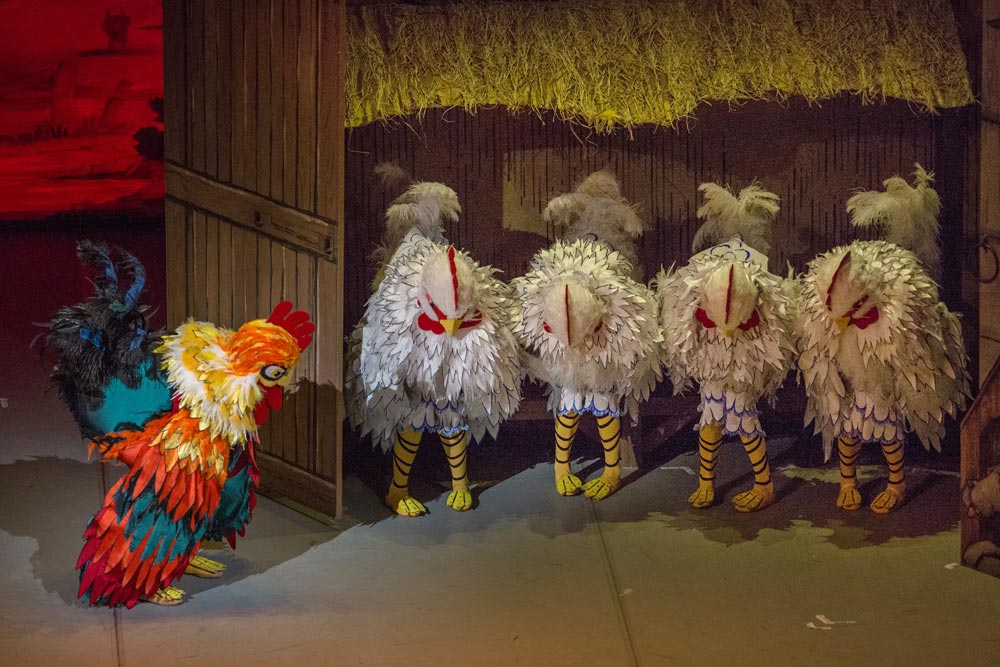
© Stas Levshin. (Click image for larger version)
Messerer’s intention was to eradicate all the embellishments subsequently added to various revivals of the ballet both by Ashton himself and by Alexander Grant on whom the role of Alain was created, and to whom Ashton bequeathed ownership of the rights. This laudable intention was largely achieved on the first two nights, although rather undermined by the many alterations made to the role of the Widow Simone by the guest artist cast to play “her” at the final performance, more of which anon.
When Grant passed away in 2011, the rights transferred to his partner of over 50 years, Jean-Pierre Gasquet, who came to the Mikhailovsky Theatre to help Messerer and his staff mount this revived staging along with Birmingham Royal Ballet’s Michael O’Hare (brother of Kevin, the Royal Ballet’s director) and the conductor, Phillip Ellis. Together – and in very little time – they have achieved a superb job.
While not all of the individual characterisations may have hit the right mark, the company overall has absorbed the special characteristics of Ashton’s “English” style in uniform mannered, lyrical lightness of movement, emphasising the plastic potential of the upper body. All of this could be seen very effectively in the assorted dancing of the farmhands and village girls throughout the ballet. The biggest change from the work as it is seen at The Royal Ballet (where it returns in April/May 2015) and BRB is that the Mikhailovsky production spreads over three Acts, placing an interval where there is just a front-of-curtain transition between the two scenes of Act 1. Personally, I think that this more even distribution of the action over three acts is preferable.
I saw all three performances on successive nights in this first run at the Mikhailovsky Theatre (where it returns for a further five performances in May) although one might be forgiven for thinking that only the final show mattered given all the attention that was devoted to Nikolai Tsiskaridze’s debut as the Widow Simone. Few Russian critics appeared to have been present at the premiere, which is a pity, since for me it was marginally the best of the three shows, entirely due to the excellent debuts in the romantic roles by two young Mikhailovsky dancers, Anastasia Soboleva (20) as Lise and Victor Lebedev (22) as Colas.

© Stas Levshin. (Click image for larger version)
Soboleva is a real find. Still only a second soloist at the Mikhailovsky, she caught the character of Lise beautifully and invested the role with a rich mix of charm and wilfulness, backed by steely technique. Her rendition of the aforementioned mime sequence was adorable. It was not exactly Soboleva’s debut in the role since she danced Lise on the Bolshoi’s main stage (in Gorsky’s choreography) as a 16 year-old at the Moscow State Choreography Academy in November 2009.
Lebedev portrays a coltish, whimsical, yet confident Colas, as well as being another excellent technician, possessing a light, high jump and fast, accurate turns that were most effective in the variation of the “picnic” pas de deux. He has boyish good looks – reminiscent of a young Roberto Bolle – and extra long legs. The one weak spot that needs strengthening lies in some aspects of his partnering, notably in the three big lifts, each of which was a struggle to achieve (although to the credit of his determined concentration he just about managed them all).

© Stas Levshin. (Click image for larger version)
Another pair took the leading roles on both subsequent nights (despite rumours beforehand that Ivan Vasiliev might appear in one of the shows). Ivan Zaytsev was rather more secure in his lifting but lacked the charisma and lightness of Lebedev and while the pas de deux were thus stronger, his variations were less attractive. His Lise was Angelina Vorontsova, the ballerina who moved from the Bolshoi following the arrest of her then boyfriend, Pavel Dmitrichenko, now serving time for his involvement in the acid attack on the Bolshoi’s artistic director, Sergei Filin.
Vorontsova is now a Principal at the Mikhailovsky and she exudes the confidence of a sunny disposition that works well in this ballet, aligned to a formidable all-around technique that made her solos particularly special. She has superb balance, which enhanced all the important pauses in her variation and enabled seamless turning in the maypole dance. Together with Zaytsev, she was more comfortable with Ashton’s fiendish Act 1 “ribbonology” than the opening night pair had been. However, for all that this was a fine and very promising debut, her characterisation of Lise seemed to be a rather one-size-fits-all portrayal of the feisty comic ballet heroine: on another day the same outlook would have equally suited Swanilda in Coppélia. It all seemed just a little too pert without the subtle variations of personality invested in the role by Soboleva.

© Stas Levshin. (Click image for larger version)
The principal comic roles of the Widow Simone and Alain, the simpleton son of a widowed wealthy vineyard owner – whom both single parents intend to be Lise’s betrothed – were played by a different performer on all three nights. Ironically, in each case it was a little like Goldilocks and her three bears: one was too much, one too understated while the third was just about right!
The first Alain, Denis Tolmachov, was undeniably funny, looking more like Harpo Marx than Harpo Marx. But, Alain is supposed to be simple and eccentrically obsessive (hence his adoration of the red umbrella). He is daft but not an idiot, and in Tolmachov’s reading he was positively certifiable! The Alain of the second-cast, Konstantin Kilinchuk, was much more understated and – for a purist – perhaps simply too tall for the role. Alexey Kuznetsov captured the hapless Alain to the best effect at the third performance, emphasising all the endearing traits with a near-perfect pitch.
Unsurprisingly, the best of the widows came in the performance from the English guest as BRB’s Michael O’Hare showed the great benefit of experience and understanding, with comic timing that was excellent but subtle. His clog dance was perfectly on the beat, contained the full range of steps and was – by some considerable margin – the best of the three efforts (but then it is perhaps not surprising that Lancashire clogs are somewhat alien to Russian dancers). Roman Petukhov – in the second cast – was the more undersold Simone, but still possessed all the right ingredients for a successful portrayal, being far more faithful to the ideal of Stanley Holden in the original cast and certainly much closer to O’Hare’s portrayal than that of the third-cast Simone.
What appears odd about Tsiskaridze’s performance as Widow Simone is that it ran completely contrary to the declared intention of paring the choreography back to Ashton’s original cast, as seen in the 1965 film. Back in 1959, Holden had replaced Robert Helpmann after a few rehearsals, the latter deciding that it was just not for him. Ashton’s biographer, Julie Kavanagh, records the choreographer as saying to Holden: ‘I’m glad you’re doing it….you never camp it up’. He is also quoted as saying that during the lovers’ final, beautiful pas de deux, Helpmann ‘would probably have been knitting or something’. Ashton has been dead for 25 years but I suspect that his fears for Helpmann’s portrayal of this travesti role would have been fully articulated in Tsiskaridze’s scene-stealing efforts. He may not have knitted in the pas de deux but his energetic comic game of patience at the side table certainly drew the eye away from the farmhands’ stick dance! If he was onstage, he was doing something and since this is Nikolai Tsiskaridze – in Russia – you can bet that the audience was watching him. It made it far less La Fille mal gardée and much more La Mère qui garde.
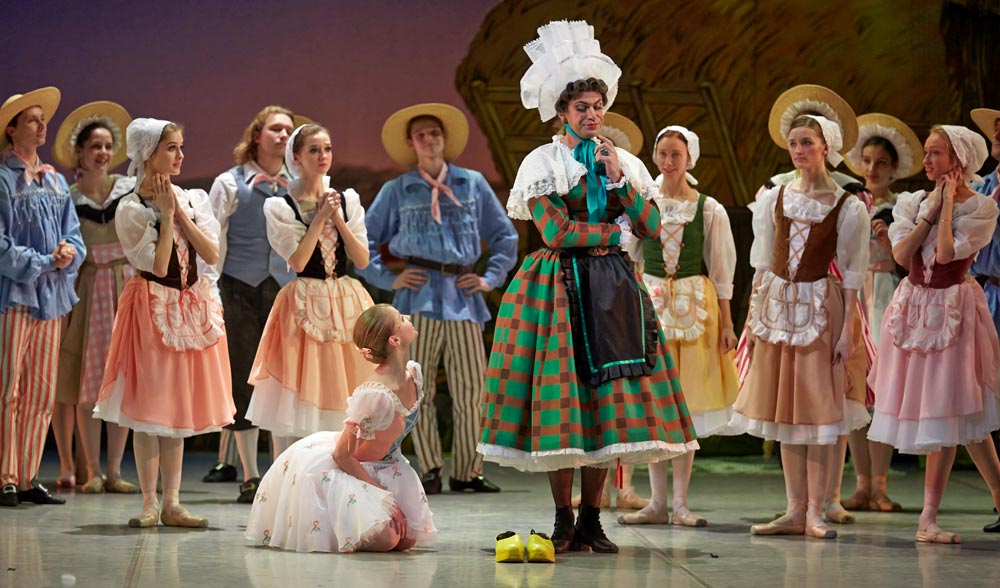
© Stas Levshin. (Click image for larger version)
Tsiskaridze’s Widow Simone was clearly a generation younger that we are used to seeing. No grotesquely bent back or grey hair here, but stiff shoulders, alert bosoms and dark, brooding good looks. Given that a liaison between Alain’s father, Thomas, and Simone is the sub-text of their offsprings’ proposed nuptials, I think the old vineyard-owner was onto a good thing (although he might have got a bit of a surprise come the wedding night)! When Tsiskaridze comes to do the double take in the mirror on leaving the farmhouse, he does so with an arabesque (although this is not unique since I recall Will Tuckett doing something similar with The Royal Ballet). If there was any opportunity to add something extra (even sweeping down the farmhouse’s external staircase) then Tsiskaridze took it, probably adding more embellishments than a generation’s worth of revivals in the modern era and thus rather defeating the object of the whole exercise! He took to the clog dance with aplomb even if not necessarily in the right combination of steps or in time with the music.
The best aspect of this third performance came in the very obvious affection that existed between Tsiskaridze’s Simone and his daughter, Lise. Tsiskaridze is Vorontsova’s mentor and he was her coach at the Bolshoi (where Filin’s refusal to cast Vorontsova as Odette was a key part of the story that has led to Dmitrichenko’s incarceration). This filial closeness translates onto the stage in La Fille mal gardée in a way that is possibly unique – it could only be replicated, I guess, by a man playing Simone alongside his actual daughter – and the genuine intimacy of their relationship was evocatively revealed in this inspired aspect of their casting. Some of Tsiskaridze’s extras reflected this closeness, especially in Simone’s overt attachment to Lise and in the theatrical asides revealing a contemptuous attitude towards Alain. Although I found the aggrandisement of the role to be at odds with both Ashton’s and this revival’s intentions, it is also true to say that Tsiskaridze’s embellishments enhanced the widow’s loving but watchful relationship with her daughter, effectively stretching it out in both directions.
The dancers of the Mikhailovsky Ballet acquitted themselves excellently not only in their assimilation of the “Ashton style” but also in performing the collection of English dances that litter the corps de ballet’s work, from Morris to Maypole and from music hall to pantomime. They managed superbly. Much credit should also go to Philip Ellis who took the tempii, especially of Acts 1 and 2, at a fair gallop and the orchestra of the Mariinsky Theatre responded to this robust pace with alacrity. The acoustics in this small and ornately elegant theatre are excellent.
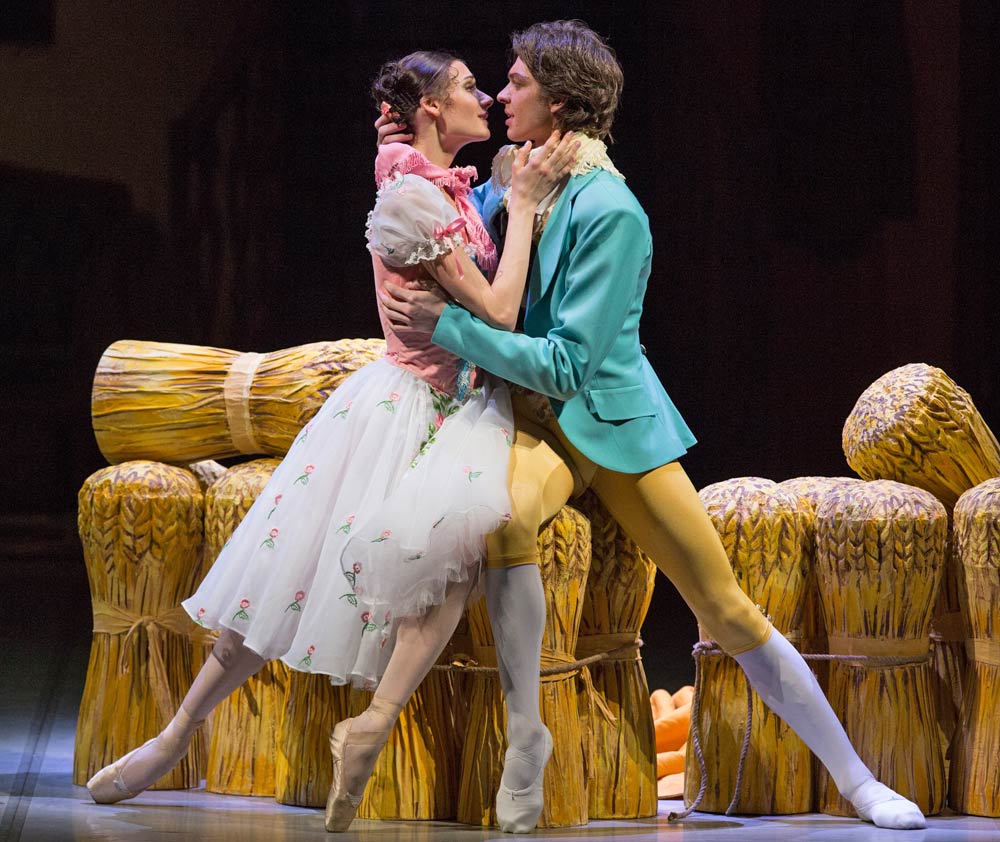
© Stas Levshin. (Click image for larger version)
The Russian audience was slow to appreciate the ballet on its first night and some of the comedy in the early scenes fell flat. The comedy dance of the cockerel (Alexander Gavrish) and his hens hardly raised a chuckle. But it was the arrival of the most charming long-maned, caramel-coloured miniature pony at the end of Act 1 (to transport the Widow and her daughter to the picnic) that deservedly broke the ice. From that moment on, and over three performances, the audience was in thrall to the bucolic genius of Ashton’s production with as many curtain calls at the premiere as I can recall witnessing for a very long time.
Although Ashton made elaborate arrangements in his will for bequeathing each of his ballets, he did not hold out much belief that they would last long after his passing, and given his love of all things connected to the ballet in St Petersburg, delicious irony exists in the fact that more than 25 years after his death, two of his five full-length ballets should receive their premieres as part of the repertory of the two main indigenous companies of that city on successive Thursdays. For just one week after this triumphant Mikhailovsky opening of La Fille mal gardée, the Mariinsky Ballet also premiered – to great acclaim – his ballet, Sylvia, as revived by Christopher Newton and Monica Mason and staged by Susan Jones of ABT. No wonder that at the Mikhailovsky Theatre, Ashton’s statuesque caricature on Osbert Lancaster’s front cloth for La Fille mal gardée seemed to be wearing a satisfied smile!
Note – the author attended this performance as a guest of the Mikhailovsky Theatre












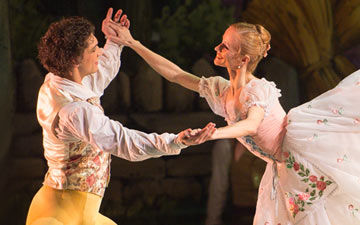

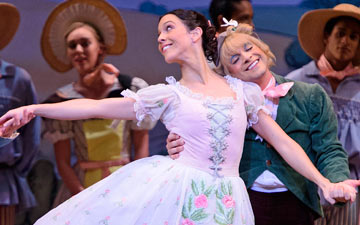


I am sure the theatre will believe it got its moneys worth by paying for a freebie visit for the reviewer.
Thanks for your comment, “anon”. I would have preferred it if you had identified yourself instead of making the posting anonymously but respect your wish to protect your identity.
One person’s view of a “freebie” is, of course, another person’s view of a job of work. I don’t know too many professional people who pay their own expenses to do their job.
In an ideal world, the magazine or newspaper would foot the bill but since Dancetabs is a free resource for you and others, that would be too much to expect. So, I’m afraid that there is little choice these days but to accept offers of hospitality from overseas companies in order to write about their work. This, after all, is just an extension of the hospitality that every critic accepts in order to write reviews in their own country (but perhaps you expect critics to buy their own tickets in order to do their job?). It is part of the accepted package.
Whenever it is relevant, as in this case, the fact that I am a guest of the host company in terms of travel and accommodation is always declared.
On this occasion, DanceTabs was one of five UK-based media attending as the Mikhailovsky Ballet’s guests (the others being The Observer, Financial Times, Dance Europe and Dancing Times).
Finally, I wonder if you read my review in its entirety? Although I am happy to concede that it was generally positive (and, in this context, certainly not out of line from the reviews in the Observer and FT) my comments about the best-known of the performers – cast by the company that gave me the “freebie” as you say – can hardly be construed as being wholly favourable.
Which brings me to the key point. Whomever pays my expenses to see a show, or provides the ticket, the views are mine. They are not bought and the people who invite me know that it is part of the deal that i will write whatever I feel to be appropriate. This review would have been written in exactly the same way had I funded my own trip to St Petersburg.
Best wishes
Graham
Just one more point of view from Russian province. I like this ballet. And i was lucky to see both Liza of Soboleva & Liza of Vorontsova and liked both.(By the way Soboleva is 22). But to my mind Liza of Soboleva was the same from the beginning. She loves Kolen and she knew what love was. Let’s say, Kolen holded Liza’s hand longer than it was allowed (and etc.). However she was very lovely and romantic but not funny enough even where it was necessary. Liza of Vorontsova was different, probably not very romantic, but very lovely and funny. First she was as a playing in love (an adult game) child/girl, and only being kissed by Kolen she fell in love and final odagio was very romantic. Taking into account that it is a comic ballet it seems to me interpretation of Liza of Vorontsova is more appropriate. Probably my view is different because of (let’s say) “russian sole”. Please excuse my english.